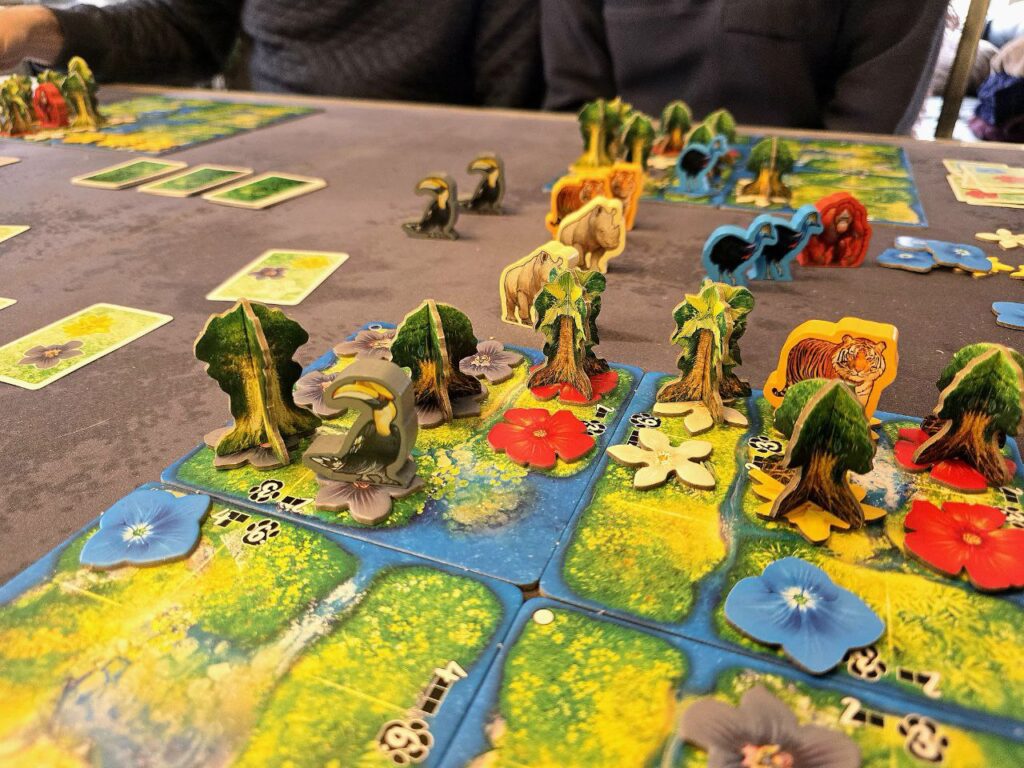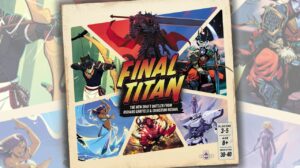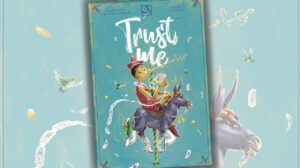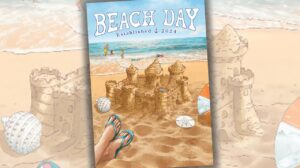Disclosure: Meeple Mountain received a free copy of this product in exchange for an honest, unbiased review. This review is not intended to be an endorsement.
Roaming the Rainforest
As someone who is half Indonesian, I did a double take when I saw the name Hutan scroll by. Hey, that’s Indonesian for “rainforest”—is that a coincidence? To my delightful surprise, it was not. Hutan is a lovely game that focuses on planting flowers and trees to develop an animal-friendly ecosystem in the jungles of Indonesia. Hutan will appeal to fans of similar nature-based games such as Cascadia, Botanik, The Isle of Cats, and New York Zoo. Designed by Asger Harding Granerud and Daniel Skjold Pedersen, and featuring the talented artwork of Vincent Dutrait, this experience resonated with my heritage. I even had a chance to sit down with one of the designers at GAMA this year for a brief run-through. Pack your rucksack and hiking boots—let’s head into the humid jungle!

Verdant Mosaic
Hutan is played over nine rounds, during which players try to build out their ecosystem as efficiently as possible to score the most points. Each player’s board hosts four tiles, each with nine sections featuring different-sized regions. Players score points by completing regions with the same-colored flowers, trees, and animals (represented by adorable, chunky meeples). However, the challenge comes from the placement rules.
Players draft a card that allows them to place one to three flowers—either of various colors or the same color—on the board. After the initial placement, flowers must be adjacent to already placed flowers (or stacked on the same color), and placement must chain from there. What seems like an innocuous rule quickly becomes a puzzle, as players score negative points for regions that are only partially completed or have mismatched colors. However, there is a solution: players can double-stack flowers, which spawns a tree for additional points in these negative regions. If a player grows the last tree in a region, it transforms into an animal (which is piece-limited), triggering additional trees to grow when placed.
The game also includes a variant with public objectives that score points based on end-game configurations, adding another layer of strategy.

Jungle Expedition
At first, I thought, Hey, this game is great! I’m sure it’s just the normal, simple solo “beat your own score” variant. I was quickly proven wrong. The game also includes a slew of scenarios that scale in difficulty, requiring players to reach a minimum score while meeting specific parameters. Believe me when I say—these aren’t easy! It took me a few attempts just to pass the first scenario.
Additionally, Hutan includes pre-made modifiers that allow players to scale the difficulty up or down. If that wasn’t enough, there are also achievements for players to complete, along with a tracker to boast about their planting success. The cherry on top is the last page of the rulebook, which serves as a science guide to Indonesia’s flora and fauna, complete with the nama dalam Bahasa Indonesia (Indonesian names). Big fan of the anggrek hitam (dark orchid) and pohon palem (palm tree)!

Strategic Seed Sowing
I simply love this game—and not just because of cultural bias. It’s a short and snappy experience (it took me longer to assemble the trees than to play a solo round!) that feels fulfilling with each play. I knocked out four solo plays in an hour, each giving me that one more turn feeling at the end.
My wife excitedly mentioned that the game reminds her of A Gentle Rain, which she described as a “cozy puzzle.” Another player said they felt like they were solving a Sudoku puzzle in the best way possible. Because Hutan plays quickly, efficiency becomes the key challenge. Early rounds feel simple, as the forest is wide open, but in the late game, space runs out fast, and you’ll be forced to expand into new regions—likely netting negative points. I’ve never had a game where someone didn’t score negative points. It’s inevitable, but the fun comes from mitigating those losses.
Placing animals becomes a strategic race, since these pieces (and their colors) are limited. Animals trigger extra flowers and trees in adjacent sections, making them one of the game’s best efficiency tools. That being said, you may perfectly set up a move, only to see the lovely yellow Sumatran Tiger piece quickly whisked away into another rainforest!
I highly recommend playing with the public objectives every time. Even if you don’t focus on them, your final board configuration will likely check off a few for some surprise bonus points.

The Canopy Calls Again
The only minor downside is that there is almost no player interaction. It’s hard to track what others are working on, and even harder to keep up with the current point standings. However, this is a common trait in tile-laying and drafting games, so expect that going in.
There’s a ton of variability in the box to keep the rainforest healthy and vibrant for a long time. The player boards are double-sided and can be arranged in any direction, creating new challenges with each play. I also have to commend the game for including a buildable insert, providing an aesthetically pleasing home for each piece.
It’s safe to say Hutan is already a top contender for my Game of the Year. The soothing and diverse world of the rainforest keeps calling me back—and I’ll happily jump into the humid jungle every time.












Add Comment